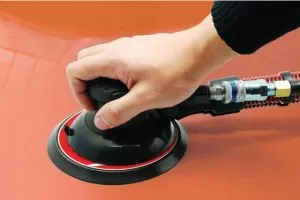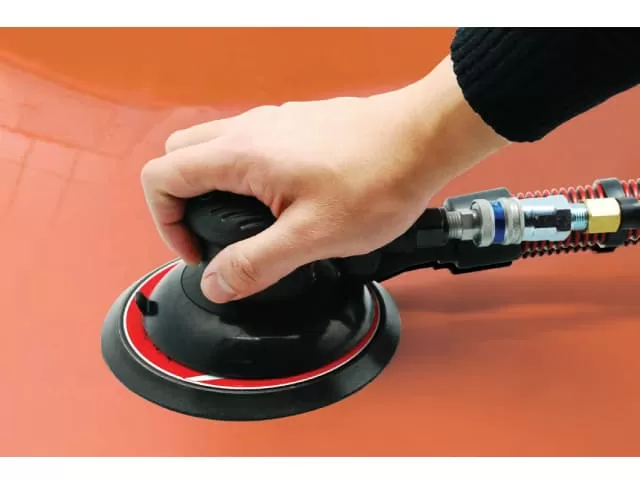What Is It And What Is It Used For ?
A pneumatic sander is a tool used to smooth surfaces by abrasion with sandpaper, using compressed air, that is why they are also called compressed air sanders. They have a special piece to join the sandpaper to the tool. They also have a mechanism to move it quickly, all contained within a housing, with possibilities to hold them by hand or to fix them to a workbench.
They are widely used for sanding wood with compressed air, saving mainly on the payment of the electricity bill. They are also widely used in the sanding of car bodywork, cars or cars. Among the brands of air sanders are the following: Dynabrade air sander, Rupes air sander, Wurth air sander, Segola air sander, Parkside air sander, Sodimac air angle sander. The 3M sandpaper is one of the most recommended.
Benefits of Using an Air Sander
- There are pneumatic sanders for wood and pneumatic sanders for cars, there are also pneumatic orbital sanders for these purposes. The benefits of these tools are as follows:
- The pneumatic sander allows a smooth handling of the tool
- The additional power control on an air sander allows it to run at high speed to speed up the work
- They have a trigger control and an action piece
- With the use of the air sander you will have considerable electrical savings and therefore a decrease in the payment of the bill
Characteristics of the Pneumatic or Air Sanding Machines
- The pneumatic sander is a high speed tool
- The compressed air sander is compact and light
- There is a built-in regulator for speed adjustment in the work of the air sander, it is a trigger action for precise speed control
Pneumatic Sander or Electric Sander Which to Choose and How to Use the Pneumatic or Air Sander ?
Both are very useful tools. Each of them has benefits in its use. You can evaluate the one that best suits your requirements. In our online store about sanding machines we strive to provide you with the most timely and useful information to help you make the decision
Using tools such as sanders makes the job easier and faster. An air compressor is one of the most versatile tools available, as air is a powerful and versatile resource that can help a tool get the job done quickly. Air can be used for a wide variety of projects, from tire inflation to automotive power tools to woodworking such as an air sander or air grinder.
Some Benefits of Using the Pneumatic Sander in Place of the Power Sander
- The high power to weight ratio of the air sander contributes to low operator fatigue.
- Air tools like the air sander run cooler and therefore do not generate heat on the job.
- The compressed air on these sanders is clean and does not present a fire or electric shock hazard.
Compared to Power Tools, Compressed Air Sanders are Pneumatic Tools that offer additional advantages, such as
- Flexibility: Pneumatic sanders can operate in areas where other energy sources are not available.
- Cost: Pneumatic sanders provide low cost maintenance and operation because they have fewer moving parts and a simple design.
- Safety: Air sanders reduce the danger of electrical shock and fire hazard. They also run cooler and cannot be damaged by overloading or stalling.
- These air sanders meet most repair, maintenance or construction needs for the professional and do-it-yourself user.
- A key difference of the air sander is the life expectancy of the product. This compressed air tool is designed and manufactured to operate in a more demanding environment.
- Never forget to check the compressor oil in case you use it to compress air to the air sander.
Why Use Electric Pneumatic Sanding Machines ?
Power sanders can save hours of tedious and tiring hand sanding or scraping, provided the right machine is selected and operated correctly.
- Safety is important. When using any power sander, always wear safety goggles to protect your eyes and a respirator or safety mask to protect against inhalation of dust.
- All portable electric sanders fall into one of three broad categories: disc sanders, orbital sanders (also called finish sanders), or belt sanders.
- As the name implies, a disc sander consists of a disc or pad that serves as a backing for a circular piece of abrasive paper. The abrasive disc can be held on the face of the backing pad by a sticky adhesive or by a bolt and large washer that passes through the center.
- In its most common form, the disc sander used by most home operators consists of a sanding disc mounted on a shaft or bar, which is then placed in an ordinary electric drill.
- However, this arrangement is not very efficient. Most electric drills do not rotate at a high enough speed for proper sanding, and when used with a sanding disc attachment, they put excessivepressure on the drill’s bearings. The bearings are designed to resist final thrust, not side thrust or twisting action.
- Household electric disc sanders are suitable only for fairly difficult jobs, such as sanding peeling paint on shingles or siding, or sanding wrought iron railings, furniture and garden equipment.
- Disc sanders should not be used on furniture, cabinets and doors, or even on most flat wood trim inside or outside the home. They are difficult to control on flat surfaces and have a strongtendency to dig and create circular gouges or swirl marks on the surface.
- When using a disc sander, put only the outer edge of the disc in contact with the work; never attempt to press the disc against the surface. Hold the tool so that the disc is always at an angle to the surface.
Also take the following into consideration:
- In most cases, it is best to place the top edge of the disc against the surface to be sanded, but this may vary depending on the position of the tool in relation to the surface and the angle at which you can work. The rule is to try to touch the surface with your hands extended and at a distance from your body so that the disc moves away and throws the sand and dust away from your face.
- Lightly touch the edge of the abrasive disc with the surface without pressing hard. Keep the disc in motion by “rubbing” it back and forth along the sanding area in a “fading” motion that will prevent the disc from digging or breaking.
- Never press hard against the surface. If the abrasive is not removing the material as it should, or if it is not working hard enough, change to a thicker disc or go over it a second time.
- Orbital sanders, also called finish sanders, have a flat pad on the bottom, with the motor mounted on top in a housing that also serves as the tool body.
- They are not the most popular type of general-purpose power sander. They operate reasonably quickly, never break or mar the surface, and leave an exceptionally smooth and flat surface.
- However, they are slow when used to remove paint or varnish, or when you have to reshape or tear down a surface in a measurable amount.
- Some models have handles on the top that project from the front and back of the housing, while others are designed so that the housing itself is the handle. The latter usually has a smaller square pad instead of the usual rectangular pad, and is designed to be held with one hand instead of two.
- This type, which has become increasingly popular among professional craftsmen in recent years, is often referred to as a “palm sander” because it fits in the palm of one hand. Because they are lighter than larger sanding machines with a rectangular sanding pad, they are less prone to wear on vertical or overhead surfaces.
- Orbital sanders get their name from the fact that the sanding pad moves in an elliptical or orbital path. Some, which are designed for a fine finish, move the pad back and forth in a straight line.
- Many models have switches or levers that allow you to switch to straight-line or orbital sanding. Orbital sanding is much faster, but straight-line (back and forth) sanding gives the finest, smoothest finish when moved parallel to the grain.
- When using an orbital sander or a finish sander, many people make the mistake of bending over hard because they think it will help the machine cut faster. In reality, pressing down hard has the opposite effect: it will cause the motor and pad action to slow down, and can cause the motor to overheat enough to damage it.
- The correct technique is to apply enough pressure on the tool to keep the abrasive paper in firm contact with the work at all times. Periodically stopping the machine and brushing or dusting the paper also helps.
- Belt sanders are the fastest and fastest cutting machines. They use an endless belt of abrasive paper that moves around two drums or sets of drive wheels, one at the front of the machine and one at the rear.
Finally:
- Abrasive belts must be properly installed to move in the direction of an arrow. They come in various sizes to fit different electric belt sanders. The most popular sizes are two and a half to four inches wide.
- Each machine will only accept the width and length for which it was designed, so be sure you know what size your machine is using before you buy new belts. Like an orbital sander, a belt sander is really only useful on flat surfaces and straight edges.
- It will remove material at a remarkably fast rate, so handle it carefully to avoid removing more material than you intended and to avoid accidentally rounding off or reshaping edges and corners. It is an excellent machine for removing paint and varnish, and for smoothing rough wood.
- Handled properly, a power belt sander can also be used to trim door edges and moldings, and is ideal for smoothing or removing flush doors, garage doors, siding and panels. Just be careful not to allow the machine to tip or fall when passing the edge or end of a panel (machines are heavy), as this will round off the end even if you do not want it to.
- Belt sanders tend to pull sharply forward when in contact with the surface because of the way the belt moves, so it is important to keep a firm grip on the machine with both hands at all times.
- Do not lower the belt forcefully to make it cut faster; this will only slow down the action and overheat the sanding belt. (Sanding belts are much more expensive than the flat sheets of abrasive sanding required for an orbital sander.)
- When using an electric belt sander, never allow it to remain on the surface in one place while the belt is moving. Due to the speed of the cutting action, this could easily create a groove or a shallow area on the surface. Start the engine while holding the tool from the surface and then bring it into contact with the surface. When you’re ready to turn off the machine, drag it up and away from the work surface.
Related Products in ALPHAPEDIA
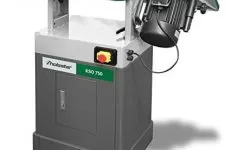
BELT SANDER for Metal, Floors and Knife Sharpening. Brands
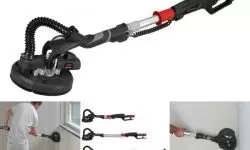
💚 WALL SANDER: ¿ How to Use It ? Brands and Models
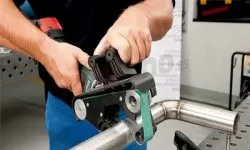
TYPES AND MODELS of WOOD and ELECTRIC SANDERS
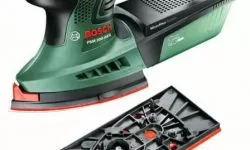
BOSCH SANDER: Great Price on Qualified Products
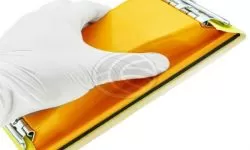
HAND SANDER: Great Price on Qualified Products
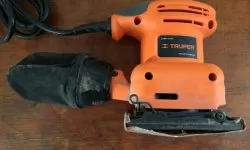
ORBITAL TRUPER SANDER: Great Price on Qualified Products
Other Topics of Interest in ALPHAPEDIA

FREE MASTER DEGREE IN OCCUPATIONAL MEDICINE

FREE CERTIFICATE PROGRAM IN FINANCE

FREE BACHELOR DEGREE IN ENVIRONMENTAL STUDIES

FREE PATTERN CUTTING AND DRESSMAKING COURSE

TEZCATLIPOCA AZTEC GOD: Meaning, Attributes and Powers of Attorney

FREE BACHELOR IN EDUCATION
Pneumatic Sander Image
